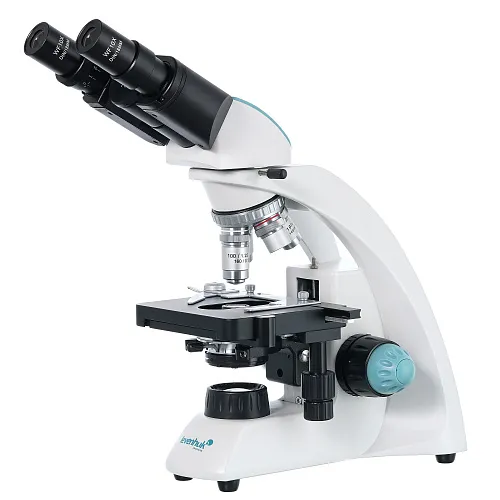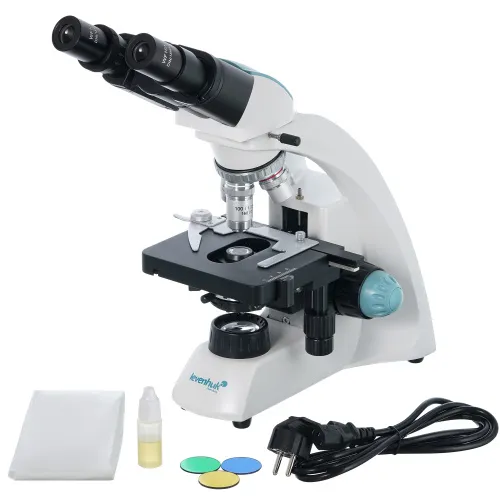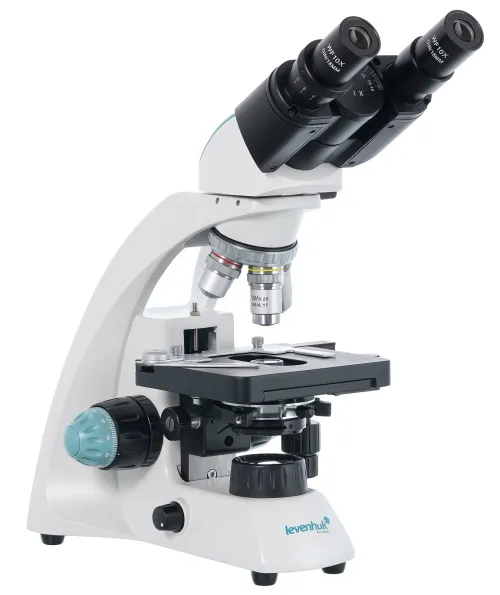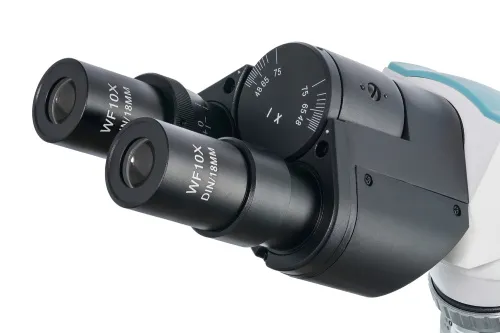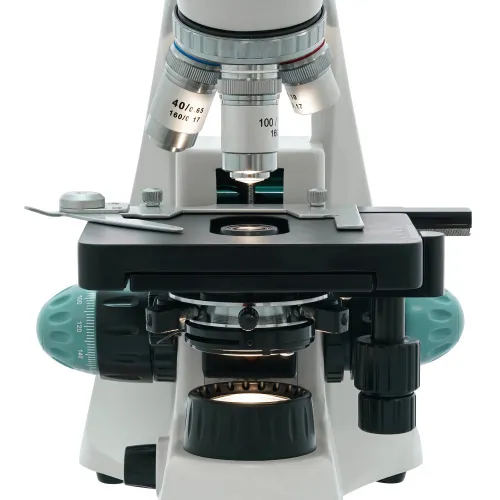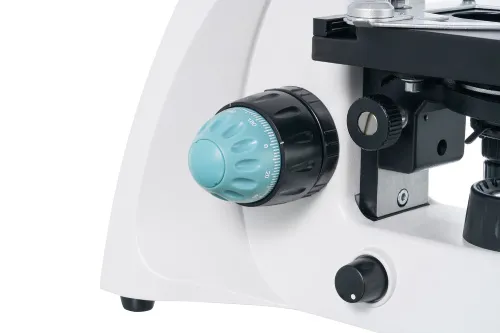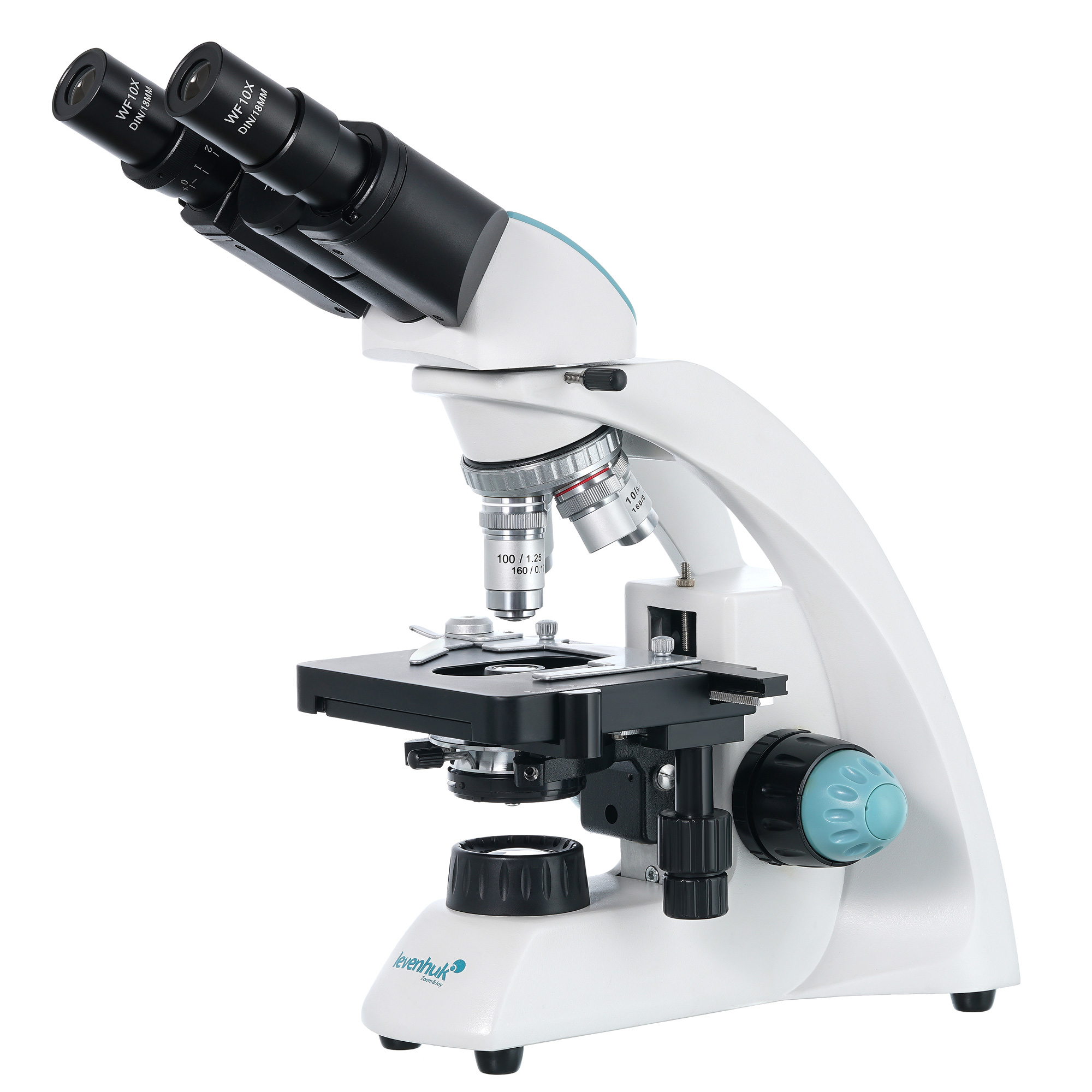Levenhuk 500B Binocular Microscope
Magnification: 40–1000x. Binocular head, achromatic objectives, halogen light with a collector
| Product ID | 75425 |
| Brand | Levenhuk, Inc., USA |
| Warranty | lifetime |
| EAN | 5905555005300 |
| Package size (LxWxH) | 42x26x33 cm |
| Shipping Weight | 4.94 kg |
Use a Levenhuk 500B Binocular Microscope in a laboratory to study stained microscope slides of plant and animal tissues. Due to the halogen light, the entire color range will be transmitted as accurately as possible, and the contrast of details will impress even the most demanding researchers. This microscope is a great choice for a biochemist, microbiologist, or veterinarian.
The microscope features wide-field eyepieces with 10x magnification and achromatic objectives with 4x, 10x, 40x, and 100x magnification. The binocular head is conveniently inclined at 30°; what's more, it is rotatable. The optics allow for examining samples at magnifications from 40x to 1000x using a bright field method as well as oil immersion. Two objectives feature front lens protection (a spring-loaded frame): 40x and 100x ones. Immersion oil is used with a 100x objective.
The microscope is equipped with a stage with a mechanical scale that helps to place the specimen accurately under the objective. Under the stage, there is an Abbe condenser with adjustable height with an iris diaphragm. You can install a light filter in a special holder. Powerful halogen lighting is equipped with a collector; there is a brightness adjustment. The lighting is powered by an AC power supply.
All of the optical elements in the microscope are made of glass. The body is made of metal.
Features:
- Binocular microscope with achromatic optics
- Conveniently inclined visual part; the head is 360° rotatable
- Wide-field eyepieces, 40–1000x optics magnification range
- Halogen light with a collector powered by an AC supply
- Brightness adjustment of the lighting, coarse and fine focusing
- Slot for installing an analyzer (an analyzer is not included)
The kit includes:
- Microscope
- 4x, 10x, 40xs, 100xs (oil) achromatic objectives
- WF10x/18mm eyepieces (2 pcs)
- Abbe condenser N.A. 1.25 with an iris diaphragm and a filter holder
- Filters: blue, green, yellow
- Fuse
- Bottle of immersion oil
- Power cord
- Dust cover
- User manual and lifetime warranty
| Product ID | 75425 |
| Brand | Levenhuk, Inc., USA |
| Warranty | lifetime |
| EAN | 5905555005300 |
| Package size (LxWxH) | 42x26x33 cm |
| Shipping Weight | 4.94 kg |
| Type | biological, light/optical |
| Microscope head type | binocular |
| Optics material | optical glass |
| Head | 360 ° rotatable |
| Head inclination angle | 30 ° |
| Magnification, x | 40 — 1000 |
| Eyepiece tube diameter, mm | 23.2 |
| Eyepieces | WF10x/18mm (2 pcs.) |
| Objectives | achromatic: 4x, 10x, 40xs, 100xs (oil immersion) |
| Revolving nosepiece | for 4 objectives |
| Interpupillary distance, mm | 48 — 75 |
| Stage, mm | 115x125 |
| Stage moving range, mm | 70/30 |
| Stage features | mechanical double-layer |
| Eyepiece diopter adjustment, diopters | ±5 |
| Condenser | Abbe condenser N.A. 1.25 with an iris diaphragm and filter holder, with adjustable height |
| Diaphragm | iris |
| Focus | coaxial, coarse (30mm) and fine (0.002mm) |
| Body | metal |
| Illumination | halogen |
| Brightness adjustment | ✓ |
| Power supply | 110–220V |
| Light source type | with a collector, halogen 12V/20W |
| Light filters | blue, green, yellow |
| Ability to connect additional equipment | a slot for installing an analyzer (an analyzer is not included) |
| User level | experienced users |
| Assembly and installation difficulty level | easy |
| Application | laboratory/medical |
| Illumination location | lower |
| Research method | bright field |
| Pouch/case/bag in set | dust cover |
We have gathered answers to the most frequently asked questions to help you sort things out
Find out why studying eyes under a microscope is entertaining; how insects’ and arachnids’ eyes differ and what the best way is to observe such an interesting specimen
Read this review to learn how to observe human hair, what different hair looks like under a microscope and what magnification is required for observations
Learn what a numerical aperture is and how to choose a suitable objective lens for your microscope here
Learn what a spider looks like under microscope, when the best time is to take photos of it, how to study it properly at magnification and more interesting facts about observing insects and arachnids
This review for beginner explorers of the micro world introduces you to the optical, illuminating and mechanical parts of a microscope and their functions
Short article about Paramecium caudatum - a microorganism that is interesting to observe through any microscope

